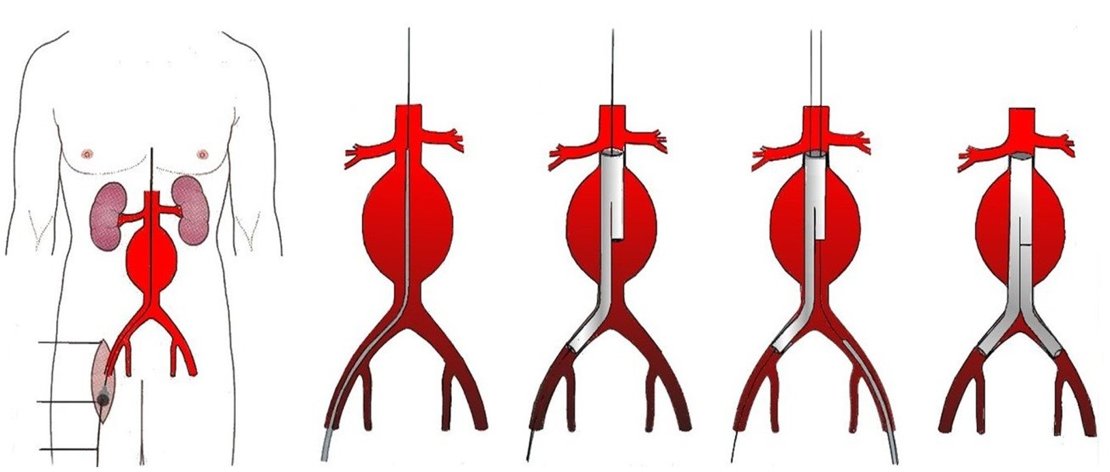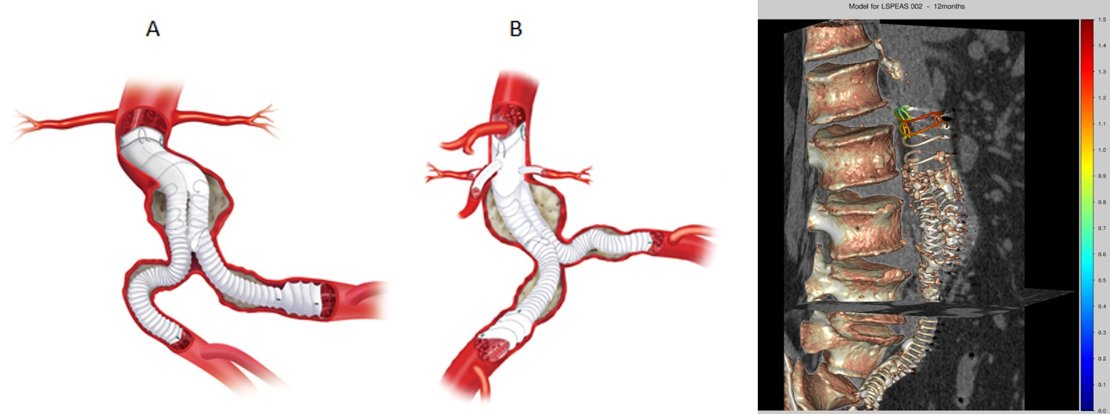Improving the Durability of Endovascular Aortic Stent-grafts (IDEAS) project
Clinical background
To prevent rupture of aortic aneurysms (locally dilated and weakened walls), a stent-graft (metal wire-frame sealed with synthetics) can be placed inside the aorta. This procedure is referred to as endovascular aortic aneurysm repair (EVAR) (Figure 1). Sealing and fixation of the stent-graft to the aortic wall is crucial for successful outcome and failure hereof is often a reason for reintervention. Reinterventions are a burden for EVAR, both for the well-being of patients and for health care costs. The pulsatile blood flow challenges the sealing and fixation, yet knowledge on the interaction with the stent-graft is limited.

Figure 1. Schematic representation of an EVAR intervention in an infra-renal abdominal aortic aneurysm. Reproduced with permission from Droc, I., B. Calinescu, and D. Raithel, Abdominal Aortic Aneurysms - Actual Therapeutic Strategies. 2012: INTECH Open Access Publisher.
Objective
The objective of this project is to evaluate the dynamic behavior of stent-grafts at the proximal sealing zone, both over time and during the cardiac cycle. To this end, we are developing and validating an image analysis algorithm for motion estimation in ECG-gated computed tomography (CT) by means of phantom experiments, landmark trajectories, and in silico simulations. With this research, we aim to identify parameters that may aid the prediction of stent-graft failure. This would allow for patient specific follow-up schemes and early re-intervention to prevent ultimate failure. In addition, stent-graft manufacturers may optimize their designs based on this knowledge.
About the project
A clinical trial was conducted in collaboration with the Medisch Spectrum Twente hospital: Longitudinal study of pulsatility and expansion in aortic stent-grafts (LSPEAS). Participants were treated electively using an Anaconda stent-graft (Figure 2 left) and were to be followed for 2 years during which ECG-gated computed tomography (CT) scans were conducted at standardized time points. ECG-gated CT enables motion analysis of implanted stent-grafts. In 2011, Klein et al. developed an algorithm to estimate stent-graft motion by means of image segmentation and registration. In this project, Klein’s method is further developed, validated and applied to clinical data. Figure 2, right, provides an example of motion estimation of the proximal dual ring of the Anaconda™ stent-graft. In March 2017, the LSPEAS-F national multicenter trial was launched, in which patients with complex abdominal aneurysms who are to be treated by fenestrated-EVAR (Figure 2 middle) are included. The patients are to be followed for 1-year by ECG-gated CT. according to protocol. This study investigates the dynamic behavior of the proximal sealing rings and the stented branch vessels.

Figure 2. Left, A representation of (A) the deployed Anaconda™ AAA stent graft system for the treatment of infrarenal abdominal aortic aneurysm and middle, a deployed Fenestrated Anaconda™ Custom AAA Stent Graft System for the treatment of juxtarenal and pararenal aortic aneurysmal disease (Image courtesy of Vascutek, a Terumo company, Inchinnan, Scotland).Right, example of motion estimation during the cardiac cycle of the proximal dual ring of the Anaconda™ stent graft. Colors denote three-dimensional amplitude of displacement during the cardiac cycle.
PhD Award Twente Graduate School
In August 2015, Maaike Koenrades has won the Twente Graduate School Research Honours PhD Award for best research proposal to obtain external funding. A 2-minutes movie has been published in which she explains her research. https://www.utwente.nl/en/news/!/2015/8/92889/maaike-koenrades-wins-tgs-award-2015
Publications
Koenrades M. A, Struijs E. M., Klein A., Kuipers H., Geelkerken R. H., Slump C. H. (2017). Validation of an image registration and segmentation method to measure stent graft motion on ECG-gated CT using a physical dynamic stent graft model. In: Proceedings of SPIE. Vol 10134;1013411-1013418. doi:10.1117/12.2254262. http://dx.doi.org/10.1117/12.2254262
Koenrades, M. A., Klein, A., Leferink, A. M., Slump, C. H., Geelkerken, C. H. (2018). Evolution of the Proximal Sealing Rings of the Anaconda Stent-Graft after Endovascular Aneurysm Repair. J Endovasc Ther 2018:1526602818773085. https://doi.org/10.1177/1526602818773085
